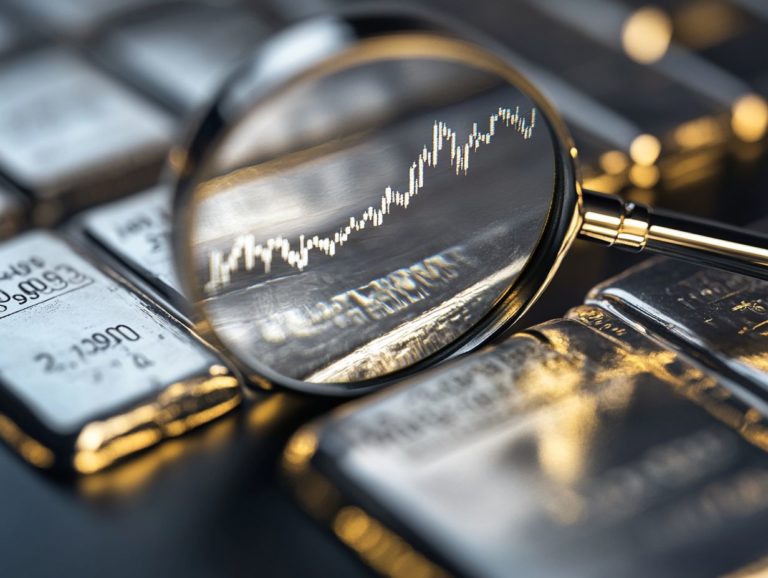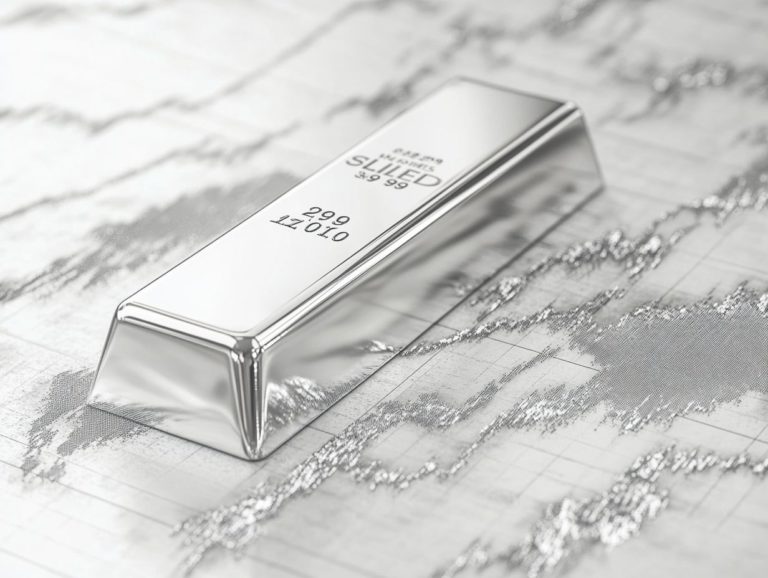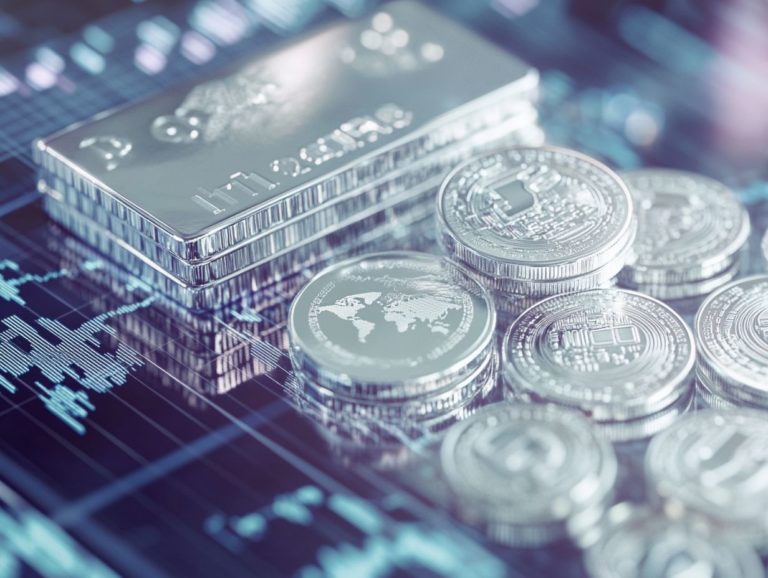How Economic Factors Influence Gold Prices
Gold has long held its status as a safe haven for investors, yet its pricing is swayed by a complex web of economic factors.
This exploration delves into how macroeconomic elements like inflation and interest rates alongside microeconomic factors, such as supply and demand, influence gold’s value.
Understanding these dynamics can give you the upper hand in making informed investment decisions and staying ahead of market trends.
Uncover strategies that could elevate your gold investment approach.
Contents
- Key Takeaways:
- How Macroeconomic Factors Impact Gold Prices
- Microeconomic Factors Affecting Gold Prices
- How Economic Factors Can Be Used to Predict Gold Prices
- Strategies for Investing in Gold
- Frequently Asked Questions
- What are economic factors and how do they influence gold prices?
- How does the stock market influence gold prices?
- How do changes in interest rates affect gold prices?
- What role does the value of the US dollar play in gold prices?
- How do geopolitical events affect gold prices?
- How does the mining supply of gold impact its price?
Key Takeaways:
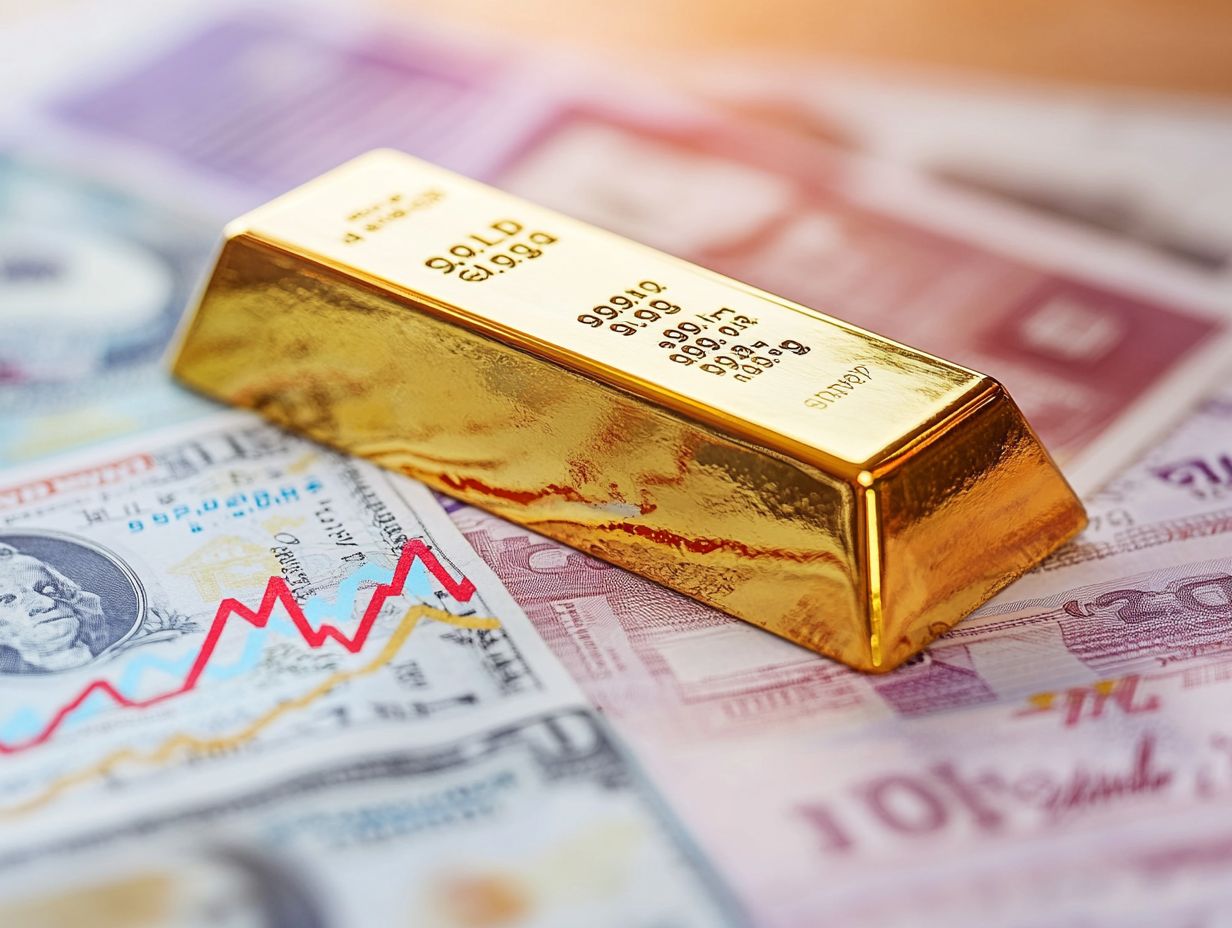
- Economic factors, both macro and micro, significantly impact gold prices.
- Inflation and interest rates, currency movements, and global economic conditions are key macroeconomic factors affecting gold prices.
- Understanding and analyzing economic data, expert opinions, and market trends can help predict gold prices and inform investment strategies.
How Macroeconomic Factors Impact Gold Prices
Macroeconomic factors are essential in shaping gold prices, as they impact key elements like demand and supply in the market.
The relationship between the U.S. dollar, inflation rates, interest rates, and economic uncertainty plays a significant role in how investors view gold as a safe haven asset.
Central banks, such as the Federal Reserve and the European Central Bank, frequently adjust their monetary policies, influencing gold price dynamics, especially during times of global conflict.
Grasping these macroeconomic factors is crucial for anticipating gold price movements in response to changing market conditions.
Inflation and Interest Rates
Inflation and interest rates are closely linked economic indicators that significantly influence gold prices, as they determine the trade-off of choosing gold over interest-bearing assets.
When inflation rates surge, you may find yourself gravitating toward gold, viewing it as a dependable hedge against dwindling purchasing power. For instance, during periods of rising inflation, the metal’s allure often intensifies, as it has historically preserved its value, acting as a counterbalance to the depreciation of fiat currencies.
Central banks frequently lower interest rates to stimulate economic growth, which further enhances gold’s appeal. As interest rates decline, the cost of holding non-yielding assets like gold diminishes, making it a more enticing option.
Recent trends show that when inflation reached a decade-high of over 6%, many investors flocked to gold, driving prices upward and highlighting the asset’s crucial role in wealth preservation during uncertain economic times.
Currency Movements
Currency movements, especially those of the U.S. dollar, wield significant influence over gold prices, as gold tends to move inversely to the dollar’s value.
When the dollar gains strength, you might find gold less attractive, leading to a dip in demand and subsequently lower prices. On the flip side, when the dollar weakens, investors often flock to gold, viewing it as a safe-haven asset particularly during times of heightened inflation or uncertainty.
Central bank policies, such as interest rate changes, are pivotal in this equation. If the Federal Reserve decides to lower interest rates, a surge in gold investments could occur; the allure of lower returns on cash and bonds nudges investors toward tangible assets.
Analyzing recent charts shows this dynamic becomes evident, with shifts in dollar strength frequently aligning with fluctuations in gold prices.
Global Economic Conditions
Global economic conditions wield considerable influence over gold prices, as heightened economic uncertainty and geopolitical turmoil often drive you to seek gold as a safe haven investment.
This connection becomes strikingly evident during crises, such as the COVID-19 pandemic, when global gold demand surged a remarkable 40% in Q2 2020 as investors, much like yourself, sought stability.
Similarly, the Gulf War in the early 1990s brought significant fluctuations to supply chains, pushing gold prices higher as uncertainty clouded oil trade and regional stability.
Historical data underscores that during periods of conflict or instability, gold frequently outperforms other investments, serving as a reliable hedge against inflation and currency devaluation. This highlights its crucial role in navigating a volatile market landscape.
Ready to deepen your understanding of gold investing? Explore more resources or consult with experts to optimize your investment strategy!
Microeconomic Factors Affecting Gold Prices
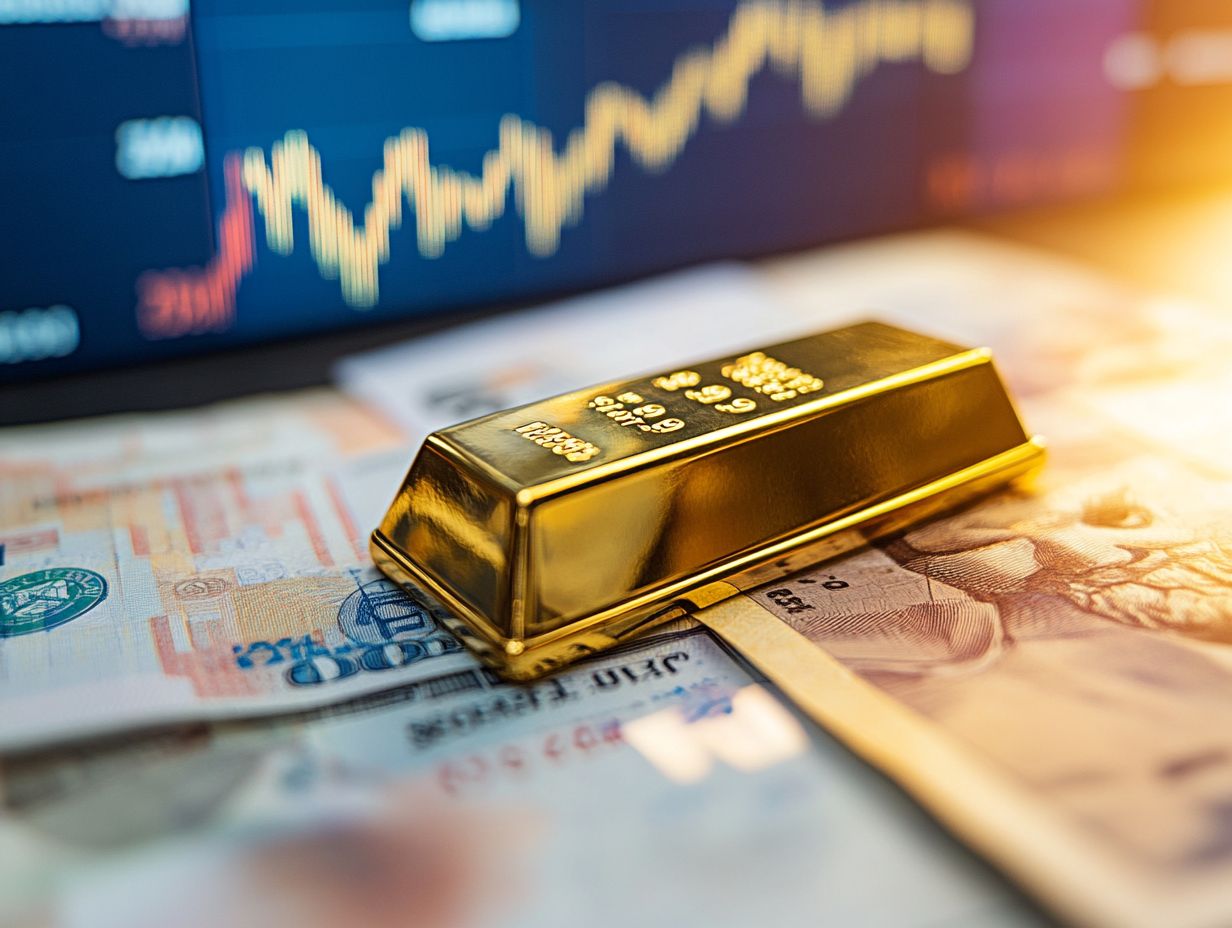
Microeconomic factors, particularly the dynamics of supply and demand, wield significant influence over gold prices. These fluctuations are intricately tied to gold’s applications in both jewelry and ways to invest, such as Exchange-Traded Funds (ETFs), reflecting its varied value in the marketplace.
Supply and Demand
Understanding supply and demand principles is essential when navigating the complexities of gold prices. Changes in production levels and consumer interest directly influence market dynamics.
For example, when gold production is robust, as seen in 2020 with a 1.8% increase in global mine output despite pandemic-related hurdles, prices tend to stabilize or even dip due to an oversupply. If mining operations encounter disruptions or face depletion, the restricted availability can lead to rising prices.
Consumer demand significantly impacts this scenario. In the jewelry and technology sectors, jewelry alone constitutes nearly half of global gold consumption. A resurgence in gold jewelry demand, particularly in markets like India during festival seasons, often coincides with price increases.
Understanding these dynamics reveals how the gold market shifts with changing outputs and consumer interests.
Investor Sentiment
Investor sentiment directly affects gold prices. When you perceive economic uncertainty, it can lead to increased buying pressure.
This connection becomes especially clear in times of economic distress. Fear and uncertainty drive you to seek safe-haven assets like gold. Historical events, such as the 2008 financial crisis, vividly illustrate this dynamic, with a remarkable surge in gold prices as market participants flocked to this precious metal, fueled by anxiety over the stability of traditional investments.
During the COVID-19 pandemic, gold prices soared while global markets crumbled, demonstrating how psychological factors like the fear of inflation and economic collapse directly influenced demand.
These examples highlight how market sentiment, rooted in your psychological responses to economic pressures, can catalyze significant shifts in investment behavior, further solidifying gold’s reputation as a reliable store of value.
How Economic Factors Can Be Used to Predict Gold Prices
Grasping the intricacies of how economic factors shape gold prices equips you with invaluable insights to anticipate future trends and make astute investment choices.
Analyzing Economic Data
Analyzing economic data, such as:
- Inflation: When inflation rises, people often gravitate toward gold as a hedge against dwindling purchasing power, resulting in increased demand and, subsequently, higher prices.
- Interest rates: Elevated interest rates can raise the opportunity cost of holding non-yielding assets like gold, making it less appealing.
- Employment rates: Lower employment figures might signal economic instability, prompting investors to seek refuge in safer assets, including gold.
- GDP growth: Understanding GDP trends can also provide insights into economic health and its impact on gold demand.
By keeping a close watch on these data points, you can better anticipate potential fluctuations in gold prices.
Stay updated on these trends to seize opportunities in the gold market!
Expert Opinions and Market Trends
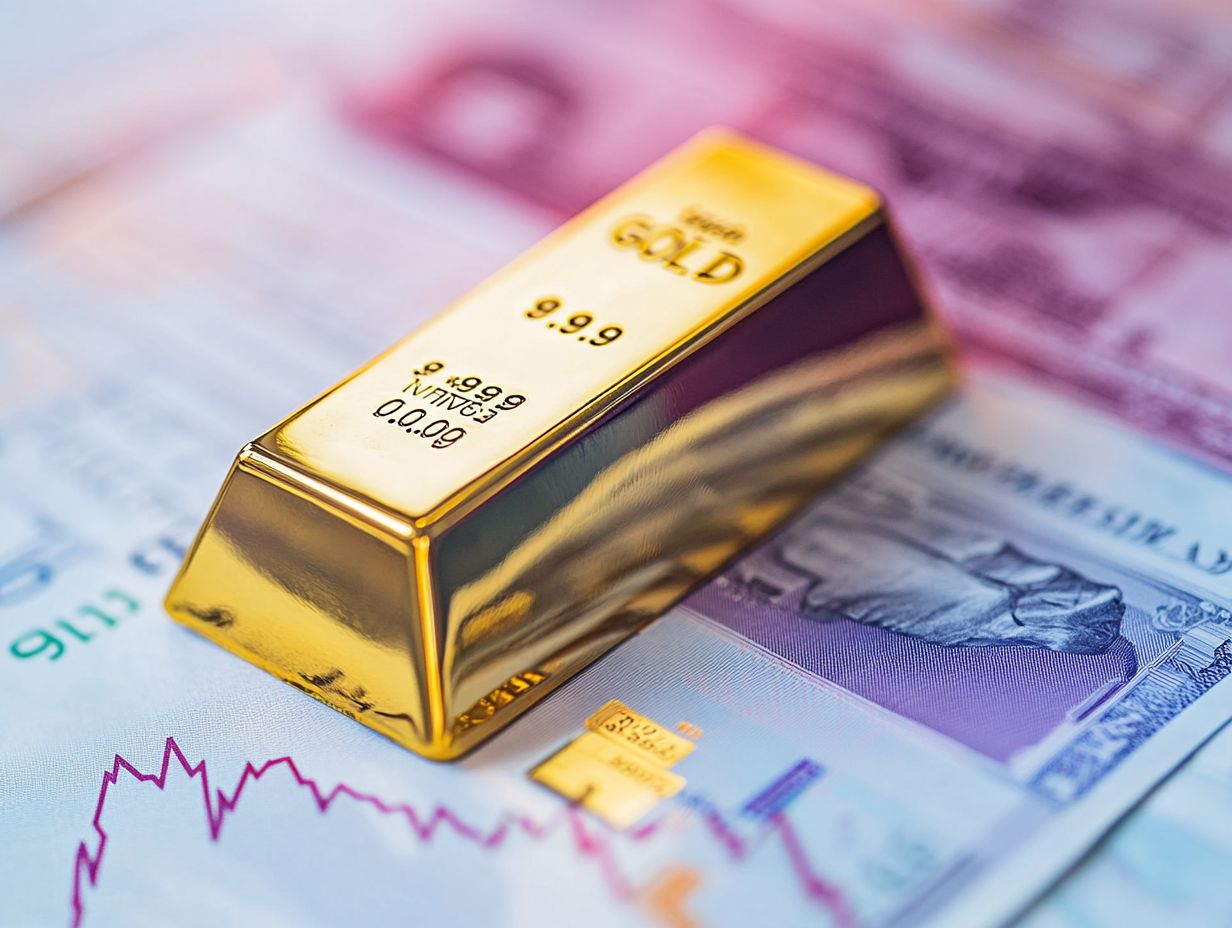
Expert opinions and prevailing market trends can offer you invaluable insights into the future movements of gold prices. This enables you to align your investment strategies with current economic conditions.
These analyses not only illuminate historical price fluctuations but also provide predictions grounded in today s geopolitical events and shifts in central bank policies. As renowned financial analyst Jane Doe points out, gold s stability often draws investors during times of economic uncertainty. With rising demand in emerging markets, industry experts are forecasting that gold could soar to unprecedented heights.
By tapping into these insights, you can navigate the market challenges with greater clarity, enabling yourself to make informed decisions in an ever-evolving economic landscape.
Strategies for Investing in Gold
Developing effective strategies for investing in gold necessitates a keen understanding of the economic factors that influence price fluctuations and market dynamics. This knowledge enables you to navigate the market challenges with confidence and precision.
Using Economic Factors to Make Informed Decisions
To make informed investment decisions in gold, you must analyze the economic factors that could influence its price, including inflation and market conditions.
Enhancing your strategy involves closely monitoring key indicators such as interest rates, unemployment figures, and currency strength. All of these play a significant role in gold s trajectory. For instance, as inflation rises, the demand for this precious metal often increases, serving as a way to protect your investment against the declining value of currency. Fluctuations in stock markets may lead you to adjust your portfolio toward safer assets like gold.
By keeping a vigilant eye on these economic metrics, you position yourself to respond swiftly to market changes. This allows you to capitalize on potential price movements while minimizing risks.
Benefits of Investing in Gold
Investing in gold brings a wealth of benefits, especially as a reliable safe haven during economic uncertainty and inflation. It s a crucial part of any well-diversified investment strategy!
Historically, gold has consistently outperformed many traditional assets, boasting an impressive annual return of around 10% over the past 50 years. During inflationary periods, when consumer prices rise, gold typically retains its value, serving as an effective hedge against the erosion of purchasing power that often comes with such conditions.
By incorporating gold into your investment strategy, you not only mitigate risks but also enhance the overall stability of your portfolio. In fact, including just 5-10% gold can reduce overall volatility and improve long-term returns, solidifying its status as a critical asset class for the discerning investor.
Frequently Asked Questions
What are economic factors and how do they influence gold prices?
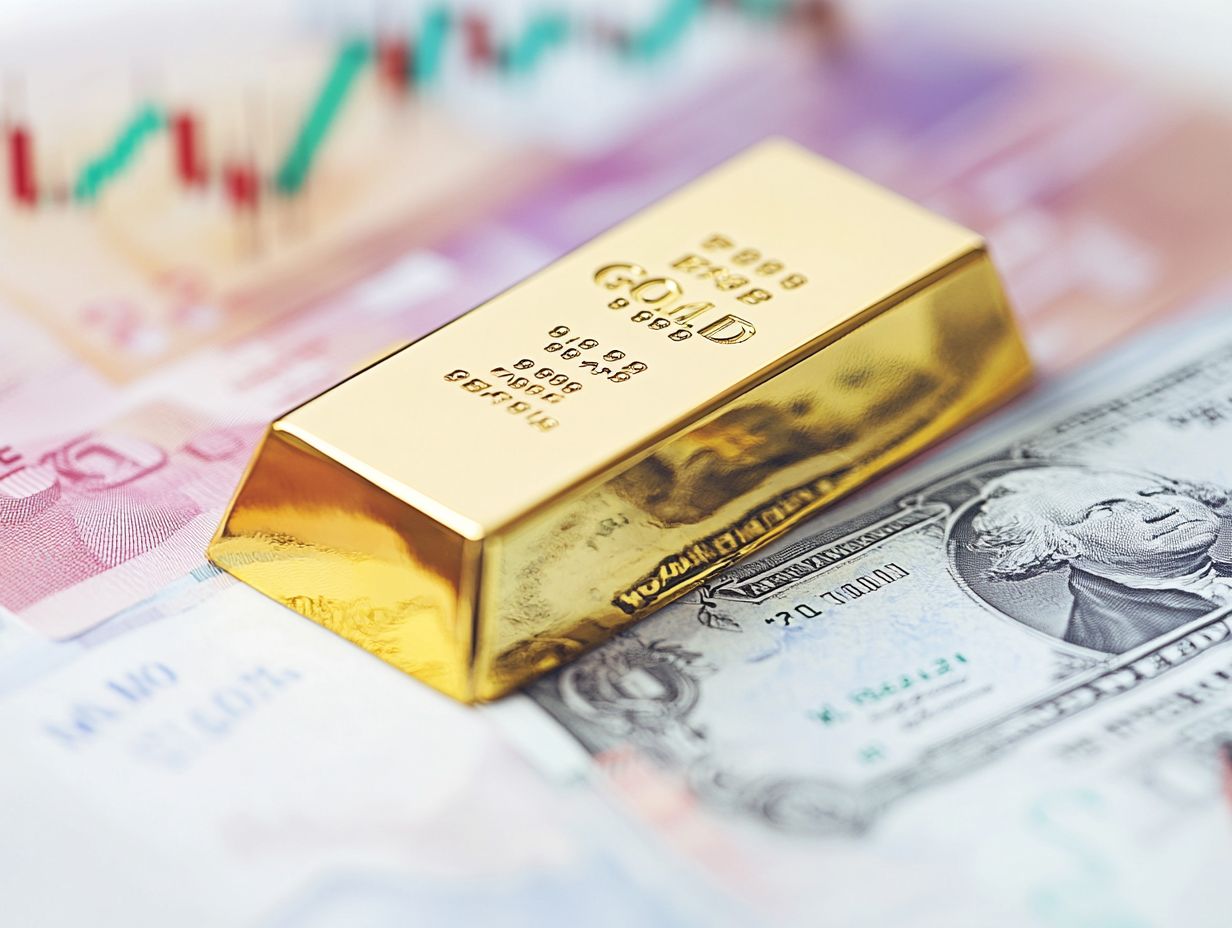
Economic factors include things like inflation, interest rates, and stock market performance. These factors can have a direct or indirect impact on the demand and supply of gold, which ultimately affects its price. For example, a rise in inflation may lead to an increase in gold prices as investors view it as a safe-haven asset.
How does the stock market influence gold prices?
The stock market and gold prices have an inverse relationship. When stock prices are high, investors may choose to sell their gold investments to invest in stocks. This leads to a decrease in demand for gold, causing its price to go down. When stock prices are low, however, investors may turn to gold as a safe-haven investment, driving up its price.
How do changes in interest rates affect gold prices?
Interest rates play a significant role in determining the demand for gold. When interest rates are high, borrowing becomes more expensive, which decreases consumer spending.
This drop in spending can lead to a decrease in demand for goods and services, including gold. When interest rates drop, borrowing costs go down. This boosts consumer spending and increases the demand for gold.
What role does the value of the US dollar play in gold prices?
Gold is priced in US dollars, so the strength or weakness of the US dollar significantly impacts gold prices. When the US dollar weakens, gold becomes cheaper for investors in other currencies, increasing demand.
When the US dollar rises, gold costs more for foreign investors. This can lower demand and result in a price drop.
How do geopolitical events affect gold prices?
Geopolitical events, such as wars, political crises, and natural disasters, create uncertainty and instability in the global economy. In times of uncertainty, investors often turn to gold as a safe-haven investment, leading to higher demand and prices.
When geopolitical tensions ease, investors often shift their focus away from gold. This can lead to a decrease in demand and price.
How does the mining supply of gold impact its price?
The supply of gold significantly impacts its price. If the mining supply increases, more gold is available in the market, which can decrease its price.
If mining supply drops, less gold hits the market. This scarcity can drive prices higher. Factors such as mining regulations, production costs, and political stability in major gold-producing countries influence the mining supply.











